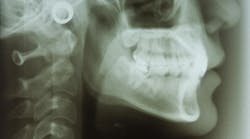Oral health and high blood pressure: Is there a connection?
Oral health may be more important than many think—especially among the millions dealing with high blood pressure (hypertension). Research shows a strong link between gum disease and hypertension. Unhealthy gums can trigger low-grade inflammation in the body, which negatively affects vascular health and increases the risk to the heart.
High blood pressure is a common condition where the force of blood against the artery walls is consistently too high, typically defined as a reading of 130/80 mmHg or higher.1 According to the World Health Organization, the number of adults aged 30–79 with hypertension has doubled in the past 30 years, reaching 1.28 billion globally.2
In the United States, hypertension is a major public health concern that affects nearly half of US adults—around 116 million, according to the American Heart Association. Yet, only about one-quarter of those affected have their condition under control.3
So, what can be done to combat this “silent killer,” a major risk factor for heart disease, stroke, and kidney damage? High blood pressure often shows no symptoms until severe complications arise, making prevention vital.
“Preventive oral care is crucial,” emphasizes Dr. Tommi Pätilä, a cardiac and organ transplant specialist at Helsinki University Hospital’s New Children’s Hospital.
While treating critically ill patients, the medical expert recognized the often-overlooked connection between oral health and postoperative complications. Driven by this insight, he set out to develop a groundbreaking antibacterial solution that could transform how we approach oral care, not only to enhance patient recovery but to prevent complications before they arise.
“The mouth serves as a reflection of overall health”
According to Dr. Pätilä, research consistently shows a connection between gum disease and various health problems, including high blood pressure. While more studies are needed to establish a definitive link, gum disease shares many risk factors with hypertension. Oral bacteria associated with gum disease have also been shown to promote inflammation in heart valves and blood vessels.
The medical expert witnessed firsthand how oral bacteria can also lead to severe heart conditions, even in young children. In 2016, during surgery for a serious heart infection, he discovered that the underlying cause was bacteria originating from the mouth. This experience deeply affected him and underscored the importance of prioritizing oral health within the medical field.
He connected with top chemists, engineers, and dental professionals to tackle the key issue in modern oral care. They developed a novel method called Lumoral, which improves dental hygiene at home by multitudes. Lumoral treatment is designed to combat two of the world’s most common health issues: untreated dental caries (tooth decay) and gum disease.
“The mouth is a reflection of overall health; maintaining oral hygiene is crucial for general well-being,” he stresses.
Periodontal disease, a serious form of gum disease, can cause gum inflammation, bad breath, and even tooth loss, with harmful bacteria being the primary cause. “When oral hygiene is neglected, oral bacteria can lead to infections that spread throughout the body, triggering inflammatory responses and systemic health issues.”
Periodontal diseases are prevalent both in developed and developing countries and affect about 20%–50% of the global population.4 This common illness can lead to tooth loss if left untreated, but it is also linked to severe heart events as well as hypertension. According to one study, a first heart attack is 30% more common in people with periodontal disease than in healthy people of the same age.5
The often-overlooked connection
Oral infections contribute to high blood pressure through several mechanisms. They can cause chronic low-grade inflammation, which stiffens arteries and raises blood pressure. Bacteria from infected gums can also enter the bloodstream during daily activities such as chewing or brushing. Once in the bloodstream, they can adhere to artery walls, causing plaque buildup, narrowing blood vessels (vasoconstriction), and further elevating blood pressure.
This inflammation also damages the endothelium, the thin lining of blood vessels, leading to vasoconstriction and increased resistance to blood flow. “This forces the heart to work harder, contributing to higher blood pressure.”
The Finnish medical expert also warns that the immune system’s overreaction to oral infections can release harmful molecules such as reactive oxygen species, which further damage blood vessels. “This ongoing inflammation not only raises blood pressure but also increases the risk of cardiovascular complications.”
According to a study published in the American Journal of Hypertension, poor oral hygiene, dental plaque, and gingival inflammation are associated with increased risk of hypertension, especially in individuals under 65 years old.6
Meanwhile another US trial involving 21,800 participants aged 30 and older from the National Health and Nutrition Examination Survey (NHANES) 2009–2018 showed that participants with periodontal disease had a 21% higher likelihood of hypertension. The study also revealed that 50.54% of participants had hypertension. Compared to those with excellent/very good oral health, the odds of hypertension increased progressively in those with good, fair, and poor oral health.7
Poor oral health disrupts the normal regulation of blood vessels and causes additional constriction, which worsens hypertension. Dr. Pätilä says, “Poor oral health is consistently linked with worse blood pressure control, which can complicate hypertension management. Individuals with periodontal disease are more likely to experience uncontrolled hypertension. Conversely, maintaining good oral hygiene, including regular brushing, flossing, dental checkups, and regular antibacterial treatment, can play a significant role in reducing the risk of high blood pressure and its associated complications.”
Hypertension is a common but treatable condition. It can be managed through lifestyle changes and, if necessary, medication. Reducing risk factors, such as lowering sodium intake, can help since excess salt increases blood volume, straining blood vessels, and overworking the heart. Other risk factors include older age and higher body mass index.8,9
A less recognized but scientifically supported—and highly significant—risk factor for hypertension is poor oral health. According to the American Heart Association, about seven out of 10 people who have their first heart attack have high blood pressure.
Dr. Pätilä believes this area deserves more attention, emphasizing the need for medical practitioners to prioritize oral health, particularly in patients with hypertension.
The importance of advanced oral hygiene
Good oral hygiene, coupled with regular dental visits, plays a vital role in maintaining overall health.
“Brushing at least twice a day and daily flossing are essential for reducing harmful bacteria in the mouth,” explains the researcher. “Regular dental checkups are equally important for the prevention and management of oral health conditions.” Additionally, avoiding tobacco, limiting alcohol intake, and adopting a healthy diet with regular physical activity can further help in combating gum disease and hypertension.
However, traditional oral hygiene methods may not always be enough. Studies indicate that even high-quality electric toothbrushes only remove about 65% of harmful oral bacteria, and this residual plaque is a significant cause of problems, both in the mouth and in other parts of the body.10,11
Dr. Pätilä, along with a team of scientists, addressed the problem of residual plaque in a new way. They developed a method that harnesses light energy into bacterial elimination. They came out with a dental plaque-attaching mouth rinse that clears dental plaque when exposed to light. With a targeted ability to eliminate the same plaque we want to get rid of by brushing, the method improves oral home care significantly.12 Recommended by the Finnish Association of Dental Hygienists, Lumoral is available in 25 European and Asian countries but is not yet sold in the US.
“Antibacterial, light-activated Lumoral treatment eliminates harmful oral bacteria and addresses gum disease. It significantly enhances traditional oral care, especially when other methods fall short or when existing oral diseases require more intensive care than brushing and flossing alone can provide.”
Preventing gum disease starts with good oral hygiene practices. Antibacterial treatments are not meant to replace brushing and flossing but to complement them. “Maintaining good oral hygiene throughout life is essential not just for oral health, but for overall well-being. This connection needs to be highlighted more within the medical field.”
Editor’s note: This article first appeared in Clinical Insights newsletter, a publication of the Endeavor Business Media Dental Group. Read more articles and subscribe.
References
- What is high blood pressure? American Heart Association. Reviewed May 20, 2024. https://www.heart.org/en/health-topics/high-blood-pressure/the-facts-about-high-blood-pressure/what-is-high-blood-pressure
- More than 700 million people with untreated hypertension. World Health Organization and Imperial College London. Press release. August 25, 2021. https://www.who.int/news/item/25-08-2021-more-than-700-million-people-with-untreated-hypertension
- Is high blood pressure inevitable? Here’s how to keep it in check. American Heart Association. May 18, 2020. https://www.heart.org/en/news/2020/05/18/is-high-blood-pressure-inevitable-heres-how-to-keep-it-in-check
- Nazir MA. Prevalence of periodontal disease, its association with systemic diseases and prevention. Int J Health Sci (Qassim). 2017;11(2):72-80.
- Rydén L, Buhlin K, Ekstrand E, et al. Periodontitis increases the risk of a first myocardial infarction: a report from the PAROKRANK study. Circulation. 2016;133(6):576-583. doi:10.1161/CIRCULATIONAHA.115.020324
- Darnaud C, Thomas F, Pannier B, Danchin N, Bouchard P. Oral health and blood pressure: the IPC cohort. Am J Hypertens. 2015;28(10):1257-1261. doi:10.1093/ajh/hpv025
- Li Y, Yuan X, Zheng Q, et al. The association of periodontal disease and oral health with hypertension, NHANES 2009-2018. BMC Public Health. 2023;23(1):1122. doi:10.1186/s12889-023-16012-z
- Grillo A, Salvi L, Coruzzi P, Salvi P, Parati G. Sodium intake and hypertension. Nutrients. 2019;11(9):1970. doi:10.3390/nu11091970
- Mitchell K, Altomara D. Causes of high blood pressure. WebMD. December 18, 2023. https://www.webmd.com/hypertension-high-blood-pressure/blood-pressure-causes
- Aggarwal N, Gupta S, Grover R, Sadana G, Bansal K. Plaque removal efficacy of different toothbrushes: a comparative study. Int J Clin Pediatr Dent. 2019;12(5):385-390. doi:10.5005/jp-journals-10005-1669
- Pussinen PJ, Könönen E. Oral health: a modifiable risk factor for cardiovascular diseases or a confounded association? Eur J Prev Cardiol. 2016;23(8):834-838. doi:10.1177/2047487316636506
- Pakarinen S, Saarela RKT, Välimaa H, et al. Home-applied dual-light photodynamic therapy in the treatment of stable chronic periodontitis (HOPE-CP)—three-month interim results. Dent J (Basel). 2022;10(11):206. doi:10.3390/dj10110206
About the Author

Nina Garlo-Melkas, MSc
Nina Garlo-Melkas, MSc, is a health and science journalist.


